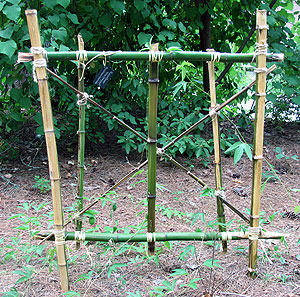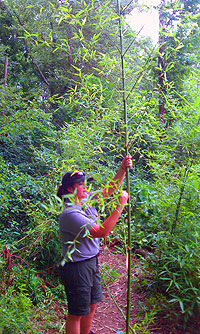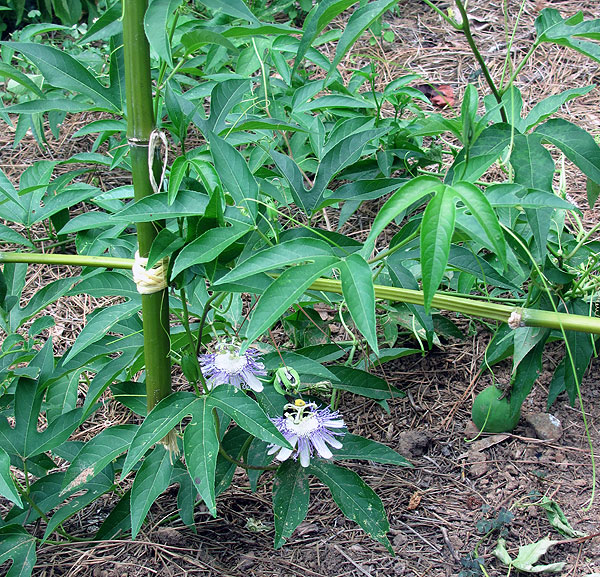Here in the Science and Resource Management division of the park, a big challenge is managing non-native species. Few residents are unfamiliar with kudzu's amazing ability to overtake untended lots, of wisteria's lavender tendrils dripping from trees or of privet's incessant propagation mission.
While we spend hundreds of hours annually treating the exotic species in the park, we are constantly looking for ways to use the byproducts of cutting down these plants. One of the ways we utilize the unwanted branches is creating habitat piles. Choosing a site in or near a wooded area, create a pile of limbs and branches of varying thickness. Birds and small animals are attracted to piles like these as they provide shelter, especially in colder winter months. Wildlife piles are great uses for woody invasives like privet and Elaeagnes.
We found another way to make use of the exotics we were treating in the park: building materials! This idea came to us as we were searching for a way to help some passionflower vines thrive. They were languishing on the ground and at constant risk of being trampled. We decided to build a trellis to allow them to climb.
 The Internet turned up cool plans to build a simple, rustic trellis from saplings and vines, which sounded like a great idea. Rather than cut down native trees, we searched for a non-native solution. What we decided to use was bamboo. There was a patch of non-native bamboo we had treated with herbicide and decided to use it as our raw material.
The Internet turned up cool plans to build a simple, rustic trellis from saplings and vines, which sounded like a great idea. Rather than cut down native trees, we searched for a non-native solution. What we decided to use was bamboo. There was a patch of non-native bamboo we had treated with herbicide and decided to use it as our raw material.
Because bamboo grows tall and is a fairly consistent width the entire length, we were able to use just a few canes for our project. With the twine we used for lashing, the entire project took just under $3 and a couple hours' time. The result was an aesthetically pleasing, useful trellis that gave our passionflower vines something to climb.
Materials
- Bamboo Canes
- Polypropylene Twine
- Loppers or Saw
- Permanent Marker
Directions
- Identify the location you'd like to install your trellis. They can be used to support any sort of vine- passionflower, watermelon, sweet peas, morning glories, Jessamine, and grapes are all options.
- Once you've identified the location for your trellis, determine the size and shape you'd like your trellis to be. Make measurements and draw a rough plan.
 Get your bamboo. It's illegal to collect from National Park Service lands, but it can be purchased online. If you know of a bamboo patch locally, contact the landowner to ask permission to harvest it. When cutting the bamboo at its base, try to cut just below one of the joints. Using a downward pulling motion or loppers, remove branches from the bamboo so you have a straight cane. It's okay to leave some small pieces of the branches on there; they will provide a place for your climbing plants to grab. Your bamboo can be as thick or as thin as you like, just remember you'll want at least two of a thick enough diameter to be the support stakes. For the trellis in this example, the long support stakes were about 1" diameter.
Get your bamboo. It's illegal to collect from National Park Service lands, but it can be purchased online. If you know of a bamboo patch locally, contact the landowner to ask permission to harvest it. When cutting the bamboo at its base, try to cut just below one of the joints. Using a downward pulling motion or loppers, remove branches from the bamboo so you have a straight cane. It's okay to leave some small pieces of the branches on there; they will provide a place for your climbing plants to grab. Your bamboo can be as thick or as thin as you like, just remember you'll want at least two of a thick enough diameter to be the support stakes. For the trellis in this example, the long support stakes were about 1" diameter.- Depending on the width of your bamboo, you can again use loppers or a saw to cut the pieces to the size you need. Make cuts near joints, especially for any lengths that will be facing upwards. (This will prevent water from collecting in the hollow bamboo and accelerating decay of the bamboo) If your trellis is going to be freestanding you need to add about a foot to any support stakes. You may also want to cut the bottom segment of support stakes at an angle to help push it in during installation.
- Once all your bamboo is cut, take it to an area where you can spread out to work. Using your plan, lay the bamboo out on the floor or work surface. You can use a permanent marker to indicate the intersections since as you work, things will move around quite a bit. Grab your twine and get ready to start lashing!
- Using the illustration below (from http://www.finegardening.com/cms/uploadedimages/images/gardening/issues_91-100/041091046-06_xlg.jpg) start lashing your bamboo together.
 Start at the outside corner and work your way down so one pole is connected in all the places it will be (for example, the top and bottom horizontal supports). Repeat the steps with the other outside pole, creating a frame. After your outside frame is constructed, attach the inner poles. You will notice as you progress that your trellis is becoming sturdier. By the time you are finished, the trellis should feel stable.
Start at the outside corner and work your way down so one pole is connected in all the places it will be (for example, the top and bottom horizontal supports). Repeat the steps with the other outside pole, creating a frame. After your outside frame is constructed, attach the inner poles. You will notice as you progress that your trellis is becoming sturdier. By the time you are finished, the trellis should feel stable. - After you've completed your trellis, it's time for installation. Depending on the location you've chosen, you may need to reinforce the trellis. If your bamboo is large enough, you can drill a hole in the bottom segment and put a piece of rebar in to help stabilize. If not, make sure you dig a deep hole and bury your support stakes deep in the ground. If your trellis will be supported by something you don't need to dig quite as deep; 6 inches should suffice. If your trellis is intended to be freestanding, you'll need to bury it about 2 feet deep.
- Once you've placed the trellis in the hole, pack dirt back in and cover with mulch if desired. Once your trellis is installed, train the vine to climb! Using twist ties, raffia, or a natural twine, attach the vine to a vertical cane. Take into consideration how your plant climbs. Some plants use tendrils to curl around whatever they are climbing, while others twine their stems or petiole (a petiole is the slender stalk by which a leaf is connected to the stem), and still others use hooks or thorns to grab on or pierce the supporting structure. Some plants also have a tendency to twine in a clockwise manner (or counter-clockwise) so when you are attaching your plant to the trellis, take a look and see which way your vine tends to twist and position it in relation to the pole accordingly. As your vine grows, you may need to continue attaching it to the trellis until it catches on itself.

